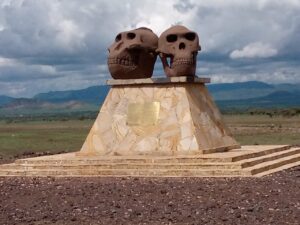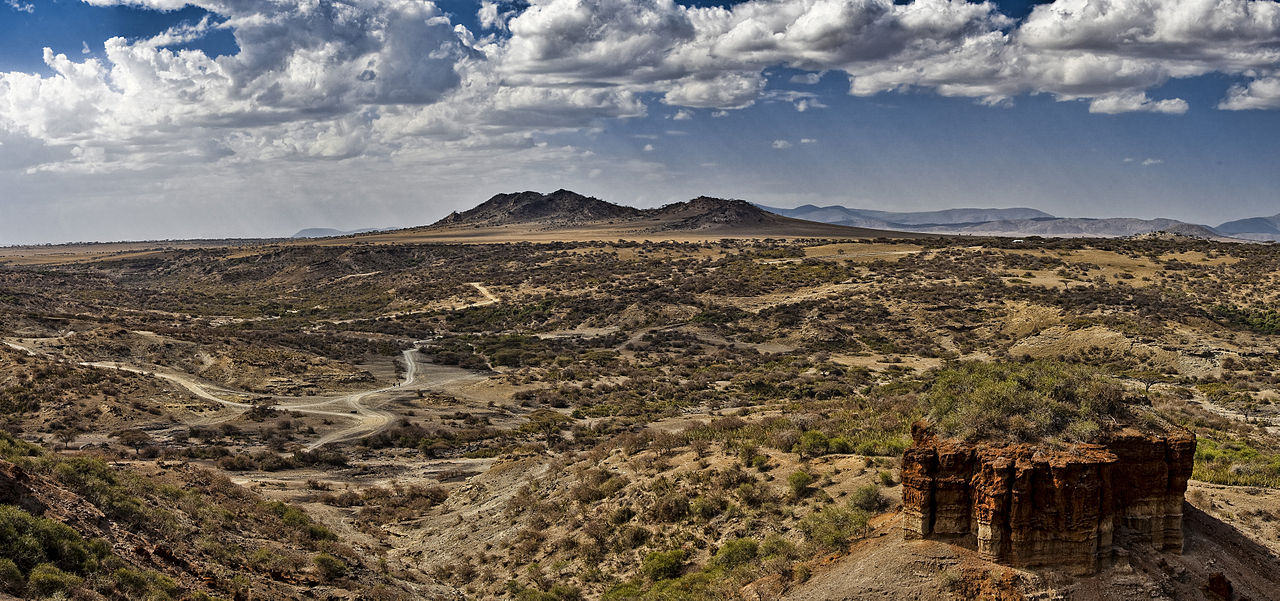The Olduvai Gorge or Oldupai Gorge is a paleoanthropological site in the eastern Serengeti Plain, near northern Tanzania, in East Africa. The gorge is nicknamed the “Cradle of Mankind” because it is believed to be the site of found remains of the first human beings to walk on Earth. Recent discoveries in Ethiopia and South Africa, however, push the age of the first humans back further in time.
The Olduvai gorge was created by erosion that spanned over 2 million years. It is a steep ravine – at 30 miles (48 km) wide, 295 feet (90 meters) deep and over 30 miles (48 km) long. A side gorge joins the main gorge about 12 miles (19 km) downstream of Lake Masek and Lake Ndutu. The word olduvai comes from the Maasai language of the Maasai people and means “the place of the wild sisal.” Sisal is an abundant plant throughout the gorge.
German physician and archaeologist Wilhelm Kattwinkel was traveling in German East Africa in 1911 and visited the area in hopes of finding artifacts. Kattwinkel found several fossil bones of an extinct three-toed horse, and his discovery inspired others to visit the area. Geologist Hans Reck led a team to the gorge in 1913, and hominin remains were discovered. World War I halted expeditions for some years; in 1931 Louis Leakey led a team to the gorge. Leakey found several hand axes, and returned to the gorge in 1935 with his wife, Mary, and geologist Percy Edward Kent.
The Leakeys continued to visit the site over the next several years, and even brought their son ,Jonathan, into their work. They uncovered tools, pieces of animal bones, and human remains. In 1960, Jonathan made a significant discovery when he unearthed a jawbone for Homo habilis, the early human species that occupied the gorge approximately 1.9 million years ago. Geologist Reck released The Geology of Olduvai Gorge in 1976, which included a detailed synopsis of five main levels to the gorge, which have since been reclassified into seven.
Bed I is the oldest and lowest in the sequence, and is made of 20-46 meters of basalt and claystone. This bed has the oldest fossils, stone tools, and human bones. Bed II consists of 21-35 meters of clay and sandstone, and a chert nodule quarry that was discovered produced over 14,000 pieces, as well as hand axes and early mammal teeth. Bed III is 6-10 meters of sandstones and conglomerates that yield a distinctly red color. Bed IV contains 5-8 meters of clays, sandstones and conglomerates. The top beds have been reclassified as the Masek, Ndutu, and Naisiu Beds and are composed of two episodes of aeolian ash from the Kerimasi volcano.

The Olduvai Gorge Museum was first dedicated in the late 1970s by Mary Leakey, and was replaced by a new building in 2018, the same year the Olduvai Gorge Monument was erected. Created by artist Fest Kijo, the monument features two large concrete skulls, depicting the first two species found at the gorge. Exhibits at the museum have featured artifacts and research from the surrounding area since its inception. Daily lectures are offered by the Antiquities guides, and safaris are available to view migrations of wildebeest, zebra, lion, elephant, and cheetah that annually pass through the gorge. Other animals seen in the gorge are giraffe, agama lizard, leopard tortoise, dik-dik antelope and Grant’s gazelle.

